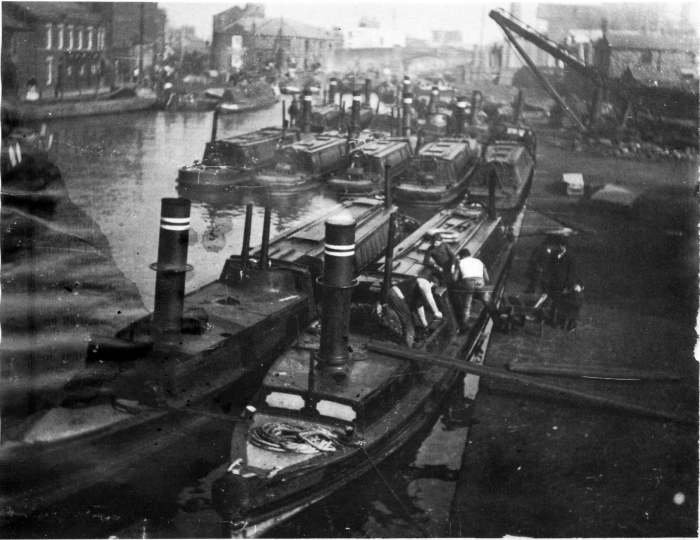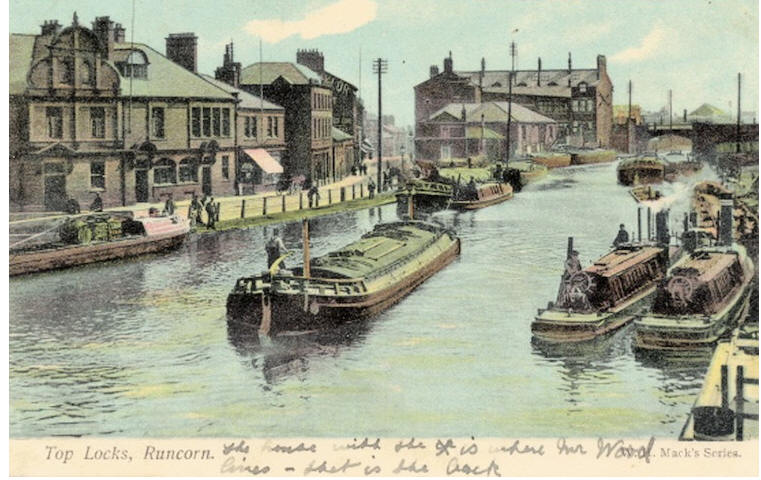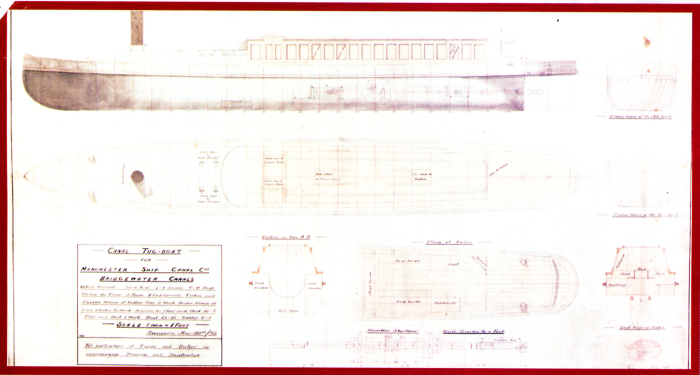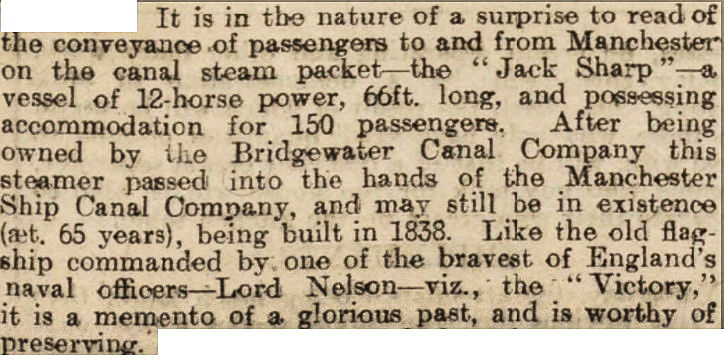

Bridgewater Canal Tugs
These craft, known as Little Packets, were generically Dukers as were all craft working on the Duke's canal. They were not strictly narrow steamers but varied in beam between 7' 10'' and 8' 9''. They are included on this site because there does not seem to be a summary of them anywhere else! I am indebted to Reg Bailey and the late Alan Faulkner for their help and to the late Alf Hayman, whose article in the Waterways Journal of May 1999 gave me the impetus to start the compilation.
(Source unrecorded) (Courtesy of Runcorn & District Historical Society)
This image contains more of these craft together than any other I have found; most the fleet is tied up at the wharf here. However, not one is identifiable, which rather reflects the situation regarding photographs. There are many pictures of Little Packets but in relatively few can a name be seen. Click on the photograph above to view more images. The postcard alongside is a later addition, identifying the location of the photograph. Many thanks to Ian Sharpe for alerting me to its existence. The scene is particularly apt, with two (unidentified!) Dukers tied up at the wharf. The card was posted in 1905. Click on http://www.runcornhistsoc.org.uk/canals_postcards/_3_top_locks_1905.html for more information
This article was written by the late Edward Paget-Tomlinson and published in Waterways World in January 1981. It is reproduced here with their kind permission and that of Edward’s widow Pam Paget-Tomlinson.
"Little Packets
Packet is a well used canal word: passenger packets, Weaver packets and, here, `little' packets -the steam and, later, diesel tugs built for service on the Bridgewater Canal.
The old Duke had been impressed with the possibilities of steam towage on his wide, deep and lock-free (except for the flight at Runcorn) canal. A steam cargo carrying barge had been tried on the canal in 1797 and a steam tug was built at Worsley at about the same time, believed to have been designed by that inventive American, Robert Fulton. J. & T. Sherratt of Salford supplied her Newcomen-style engine, not the best type for a boat, but the Watt design was protected by patents which fortunately expired in 1800. Nevertheless the `Buonaparte' as the horse boatmen derisively called her (she would have been `Kaiser Bill' in 1914) ran successful trials towing eight craft, laden with 25 tons of coal each, from Worsley to Manchester.
She did not continue in service after 1799, but the Duke became impressed with the work of William Symington on the Forth & Clyde Canal. His Charlotte Dundas of 1802 escaped the Watt patents and ran so successfully (but to the detriment of the canal banks), that the Duke wanted Symington to build eight steam tugs for his canal. But the order was never carried out, for the Duke died in 1803 and his trustees cancelled it. Like their fellow proprietors in Scotland they were fearful of bank damage, although they showed great interest in steam towage on the Mersey. No steam tugs appeared on the Bridgewater Canal until 1859 when the 16hp tug Result towed five craft at 3 mph, purely as a trial. Further developments had to wait until the trustees sold their canal to railway interests in 1872.
The new Bridgewater Navigation Co had as their first general manager and engineer the younger Edward Leader Williams, who came from the steam conscious Weaver. He proposed tugs on the Bridgewater to save money. Initially he allowed John Fowler of Leeds, the maker of steam cable ploughing engines, to try a cable tug, which would pick up and pay out a wire rope laid in the bed of the canal, and so haul itself and its train along. Cable towage was much favoured on European rivers and some canals and was once considered for the Trent and the Severn. Only a low powered engine was needed, even against the stream, but on the busy Bridgewater there would be problems of meeting other craft and overtaking. Several cables might have been needed, leading to further problems of entanglement.
Leader Williams played safe and in 1875-6 ordered six fine lined screw tugs, followed by a further twenty, all of Low Moor iron, except one, the wooden Runcorn built at the Old Quay, Runcorn, the Mersey & Irwell yard. The others came from Richard Smith of Preston and Edward Hayes of Stony Stratford, on the Old Stratford Branch of the Grand Junction Canal. Hayes, originally an agricultural engineer, specialised in small steam craft for river and lake service abroad, remaining in business until 1925. Design and dimensions of the `little packets', as the new tugs were christened, varied at Preston and Stony Stratford. Lengths ranged from 59ft 6in to 61ft and breadth from 7ft 7in to 8ft 8in. Draught was standard at 3ft 9in. The shape of the sterns varied too: some were bluntly pointed; some round; others rounded, but with the curve squared off. All were named after places on the Bridgewater and linking canals, as follows: Ashton, Bolton, Broadheath (near Altrincham), Burford (near Lymm), Bury, Dunham, Haywood, Latchford, Leigh, Liverpool, Lymm, Manchester Norton (near Runcorn), Patricroft, Preston (Preston Brook), Rochdale (the first to be delivered to the canal), Runcorn (the wooden one), Salford (later re-named Thelwall), Stalybridge, Stockton (Stockton Heath, near Warrington), Stretford, Todmorden, Walton (near Warrington), Warrington, Wigan and Worsley.
Propulsion was by a single cylinder horizontal engine, the cylinder measuring some 16in stroke by 12in bore, too large to fit athwartships, so set parallel with the keel with a right angled bevel drive to the four bladed screw. The screw, about 7ft pitch, 36in diameter, turned at 200rpm. Steam came at 80psi from a horizontal locomotive-type boiler set well forward, coal fired, with the bunkers to port and starboard of the barrel. There was no condenser, the steam exhausting to the atmosphere, so the tugs `puffed' but not with the fierce blast of a locomotive. The tugs took their water direct from the canal by means of a brass ram pump on the port side of the engine, driven from the crankshaft. An injector was fitted on the starboard side. The feed water passed through a coil heated by exhaust steam. The bunkers were filled from hatches in the boiler casing and there was a hatch in the casing ahead of the smokebox to give access to the tubes.
In the early days the `little packets' were divided between the Bridgewater and the Mersey & Irwell Navigation, but on completion of the Manchester Ship Canal in 1894 they worked on it too. They had probably helped with towage work during construction, the Ship Canal Company having bought the Bridgewater and Mersey & Irwell in 1887. Four laden flats was the usual tow on the Bridgewater and six in two columns of three on the wider cross section of the Ship Canal. The wash passed between the columns. On the upper Mersey they towed as many flats as they could hang on.
A tow from Runcorn top lock to Manchester could take 8½ hours, depending on the number and weight of the flats, while a packet would take six hours by herself. Another duty was taking flats between the bottom of Runcorn locks and the side locks from the Ship Canal into the Mersey at Weston Mersey, Bridgewater lock, Runcorn, and Old Quay lock. At the side locks the tows were handed to or collected from a Mersey tug, most usually a Bridgewater Department one. This was a tidal traffic, day and night, so the tugs had sleeping accommodation in the cabin aft of the engine: three box-type berths for skipper, engineer and lad, the last in a cross berth. There was a table cupboard as in a narrow boat and a stove with a tall chimney, in two sections. All tugs were fitted with wheel steering and the skipper could sit on a stool above the water barrel. Towing was from a curved bar abaft the wheel, furnished with two hooks, for the two lines of flats.
Crews did not work shifts, but stayed throughout with their own vessels. They were on duty day and night for a week at a time, as if they were at sea, only getting home for certain at weekends. It seems excessive hardship nowadays for they would all live locally, mainly in Runcorn, and their trips were not long. However it was accepted practice on the Weaver too. With the 48 hour week, overtime came to be paid; five trips to Manchester from Runcorn constituted the working week.
No roses and castles cheered these craft. They had black hulls, red boot topping, crimson cabin side-panels edged by dark brown frames, dark red or crimson boiler casings and black funnels, hinged for low bridges. On the funnels were the two narrow white bands of the Bridgewater Navigation Co, inherited from the Duke's trustees and passed on to the Manchester Ship Canal Co. The name was in yellow, on each bow and across the stern, surrounded by some scroll work at the bow. No port of registration was carried.
Great changes came to the little packets in the 1920s. In about 1926 the Stockton was converted to diesel and given extensive trials with a 50bhp two-cylinder Widdop semidiesel. They were successful and a further eighteen were converted by about 1928. The remainder, all of narrower beam, were scrapped, the Dunham, Leigh, Norton, Patricroft, Wigan and Worsley, and finally the broader Liverpool in 1931. She was a work boat, with steam pumps, and did a lot of ice-breaking, although all the tugs shared in this. Diesel power gave the remaining tugs a long life. One, the Bolton, was sold to Manchester Collieries in 1936 and was re-named Sir Harry, and the Lymm went to Richard Abel & Sons of Liverpool in 1947 as a general purpose tug. They re-named her Dovedale and gave her a modern squat funnel and a wheelhouse. She was not broken up until the end of the 1960s. The Broadheath went to the National Coal Board in the early 1950s. Manchester Collieries had had a tug called the Ellesmere since 1912, a steamer like the little packets, but given a Widdop in 1935. These colliery tugs worked between the numerous pits on the Leigh branch and Manchester's power stations.
With the boilers out, the casings forward were fitted with twin diesel fuel tanks of a total capacity of 250 gallons. A much shorter funnel appeared amidships for the exhaust, but otherwise appearance and livery were unchanged. Duties did, however, vary; some packets joined the MSC dredging department, others worked between Salford docks and the Irwell, a few were employed on the Bridgewater and some were designated spare. This was the 1930's picture when traffic was not so bright. A livery change came after 1939, cream cabin sides, framed in green with the slogan USE INLAND WATERWAYS on the erstwhile boiler casing, but the funnel remained black with two white bands. This green and cream was adopted for the new steel Bridgewater lighters built between 1948 and 1957, all named after Cheshire meres. Three new diesel tugs appeared in 1951/2 built by Isaac Pimblott at Northwich, and the little packets had little to look forward to. They were mostly scrapped at the company's Sprinch yard, Runcorn in the early 1950s. The wooden Runcorn had been broken up in 1948, and the last to survive as a Bridgewater Department tug seems to have been the Stockton, although outlived by the colliery tugs and the Dovedale. The colliery tug Ellesmere may still be afloat, and the Manchester may well be a house boat. Low Moor iron has a remarkable life."
Click here to view extracts (which will download as a separate document) from the General Manager and Engineer’s Reports to the Directors of the Bridgewater Navigation Co Ltd 1874-1879. These relate to the period when they had just started to order the Little Packets.

A plan showing the construction of a Little Packet. Dated 1893, 12 years after the building of the last tug, it possibly relates to a cancelled order (Boat Museum, Ellesmere Port)
The conversion of the tugs to diesel power was featured in the magazine Motor Boat in 1927. Click here to see the pages.
| Name | Authorised | Cost | Builders | Delivered | Reg. | Date | Steerer | Fate | Photo | Notes | ||
| Hull | Engine & Boiler | |||||||||||
|
PRESTON (not a Little Packet) |
Runcorn yard | 2 cylinder 25hp | 1867 | Yes | 69' x 14' 6''; Wooden, built for Bridgewater Trustees, passing to Bridgewater Navigation Co in 1872 and to the Upper Mersey Navigation Commission in 1885. Used for buoy maintenance in the Mersey Estuary. Broken up in 1929. (Details of craft from Alan Faulkner) | |||||||
| 1 | LIVERPOOL | 2 Feb 1874 | £830 | Edward Hayes | Edward Hayes | June 1874 | 502 | 25 Feb 1879 | Robert Yates | 1927/8 diesel | 57' long; transferred to MSC Co 1927; scrapped 1931 | |
| 2 | ROCHDALE | 2 Feb 1874 | £830 | Edward Hayes | Edward Hayes | July 1874 | 432 | 25 Feb 1879 | Thomas Banner | 1927/8 diesel | 57' long;transferred to MSC Co in 1928; disposed of prior to 1947 | |
| 3 | MANCHESTER | 2 Feb 1874 | £830 | Edward Hayes | Edward Hayes | Aug 1874 | 439 | 25 Feb 1879 | Thomas Brown | 1927/8 diesel | Yes 2 | 57' long; sold June1949 to G.Howard (scrap dealer), sunk in Billinge Flash prior to 1963,raised 1982 and sold to Ellesmere Port Boat Museum |
| 4 | RUNCORN | 2 Feb 1874 | Bridgewater Nav.yard,Old Quay,Runcorn | Plenty & Sons 9 hp costing £350 | Oct 1874 | 500 | 25 Feb 1879 | William Banner | 63' x 9' wide (or 68' x 10' 6''). Used for towing in the Mersey Estuary. | |||
| 5 | WARRINGTON | 28 Feb 1874 | £871 | Edward Hayes | Edward Hayes | Dec 1874 | 496 | 25 Feb 1879 | John Hopley | 1927/8 diesel | 59' 3'' x 8' 6'' x 5' 2''. Sunk by coaster 'Bassethound' at Stanlow 8 Apr1948. broken up at Sprinch Yard, Runcorn at a later date | |
| 6 | NORTON | 29 Jan 1875 | £800 | Edward Hayes | Edward Hayes | Mar 1875 | 524 | 25 Feb 1879 | Henry Smither | 1928 scrap | Sold to W.Lister for scrapping 1928 | |
| 7 | WORSLEY | 29 Jan 1875 | £702 | Richard Smith | Marshall & Sons | Oct 1875 | 523 | 25 Feb 1879 | George Roylance | 1928 scrap | Yes | Sold to W.Lister for scrapping 1928 |
| 8 | SALFORD | 29 Jan 1875 | £702 | Richard Smith | Marshall & Sons | Oct 1875 | 495 | 25 Feb 1879 | Thomas Broady | 1927/8 diesel | Transferred to MSC Co and renamed renamed 'Thelwall' 1928; registration closed 2 Mar 1954 | |
| 9 | LEIGH | 29 Jan 1875 | £702 | Richard Smith | Marshall & Sons | Nov 1875 | 440 | 25 Feb 1879 | John Smith | 1928 scrap | Sold to W.Lister for scrapping 1928 | |
| 10 | STRETFORD | 29 Jan 1875 | £702 | Richard Smith | Marshall & Sons | Feb 1876 | 522 | 25 Feb 1879 | William Bloor | 1927/8 diesel | Yes 6 | |
| 11 | LYMM | 29 Jan 1875 | £702 | Richard Smith | Marshall & Sons | Feb 1876 | 501 | 25 Feb 1879 | William Nutter | 1927/8 diesel | Yes | Sold to Richard Abel & Sons,Liverpool 1947, renamed 'Dovedale', broken up at Ellesmere Port 1960's |
| 12 | PATRICROFT | 29 Jan 1875 | £702 | Richard Smith | Marshall & Sons | Jan 1876 | 505 | 25 Feb 1879 | change tug | 1928 scrap | Yes | Sold to W.Lister for scrapping 1928 |
| 13 | TODMORDEN | 24 Mar 1876 | £760 | Richard Smith | Marshall & Sons | July 1876 | 503 | 25 Feb 1879 | James Wylde | 1927/8 diesel | Yes | |
| 14 | HEYWOOD | 24 Mar 1876 | £760 | Richard Smith | Marshall & Sons | July 1876 | 516 | 25 Feb 1879 | Edward Maddocks | 1927/8 diesel | Yes | Sold & scrapped 1951 |
| 15 | ASHTON | 24 Mar 1876 | £760 | Richard Smith | Marshall & Sons | Sept 1876 | 437 | 25 Feb 1879 | John Parr | 1927/8 diesel | Disposed of prior to 1947 | |
| 16 | STALYBRIDGE | 24 Mar 1876 | £760 | Richard Smith | Marshall & Sons | Oct 1876 | 517 | 25 Feb 1879 | John Ormes | 1927/8 diesel | ||
| 17 | LATCHFORD | 24 Mar 1876 | £760 | Richard Smith | Marshall & Sons | Dec 1876 | 438 | 25 Feb 1879 | Abraham Lloyd | 1927/8 diesel | Yes3 | Sold & scrapped 1951 |
| 18 | BROADHEATH | 24 Mar 1876 | £760 | Richard Smith | Marshall & Sons | Jan 1877 | 506 | 25 Feb 1879 | Charles Williams | 1927/8 diesel | Yes 2 | Sold to N.C.B. May1947 (name unchanged). Widdop engine replaced by Gardner 75bhp.) |
| 19 | BURFORD | 23 Feb 1877 | £744 | Richard Smith | Marshall & Sons | Aug 1877 | 512 | 25 Feb 1879 | William Streets | 1927/8 diesel | ||
| 20 | STOCKTON | 23 Feb 1877 | £744 | Richard Smith | Marshall & Sons | Aug 1877 | 504 | 25 Feb 1879 | Mark Ellison | 1927/8 diesel | First tug converted to diesel with a Widdop 50bhp | |
| 21 | PRESTON | 23 Feb 1877 | £744 | Richard Smith | Marshall & Sons | Aug 1877 | 444 | 25 Feb 1879 | Joseph Pratt | 1927/8 diesel | Yes | |
| 22 | BOLTON | 20 Sep 1878 | £743 | Richard Smith | Marshall & Sons | 656 | 30 May 1879 | Robert Yates | 1927/8 diesel | Yes 2 | Sold to Manchester Collieries 1936, renamed 'Sir Harry' after director Sir Harry Speakman, remaining in service until 1957 then converted to a houseboat | |
| 23 | BURY | 20 Sep 1878 | £743 | Richard Smith | Marshall & Sons | 700 | 3 Nov 1879 | John Smith | 1927/8 diesel | Yes | Sold & scrapped 1951 | |
| 24 | WIGAN | 18 Oct 1878 | £743 | Richard Smith | Marshall & Sons | 694 | 26 Aug 1879 | Henry Smethurst | 1928 scrap | Yes | Sold to W.Lister for scrapping in 1928 | |
| 25 | DUNHAM | 30 Dec 1881 | £800 | Richard Smith | Marshall & Sons | 776 | 3 Jan 1883 | William Blower | 1928 scrap | Sold to W.Lister for scrapping in 1928 | ||
| 26 | WALTON | 30 Dec 1881 | £800 | Richard Smith | Marshall & Sons | 775 | 3 Jan 1883 | Thomas Broady | 1927/8 diesel | Yes | Transferred to MSC Co in 1928; Sank after collision with coaster 'Yorkshire' (Liverpool) by Mersey Weir,Irlam 24 Aug 1914 (only the skipper of three crew survived). Raised and returned to service. Broken up Castlefields, July 1956 | |
| ELLESMERE (not a Duker) | 1875 | Richard Smith | 644 | 30 May1879 | Yes 2 | Operated from 1912 by Manchester Collieries; converted to Widdop semi-diesel in 1935 | ||||||
| Edward Hayes- Stoney Stratford, near Old Stratford, ceased trading 1925. The boats were delivered to Manchester by road on trailers. | ||||||||||||
| William Marshall Sons & Co. - Gainsborough (River Trent), took over the British Leyland tractor factory in Scotland 1982 | ||||||||||||
| Richard Smith & Co. - Old Quay, Preston. Moved to Lytham 1885, business renamed Lytham Shipbuilding & Engineering Co . 1895 | ||||||||||||
| Bridgewater Navigation Co. yard Old Quay, Runcorn became the engineering workshops for ‘The Manchester Ship Canal Company’ on acquisition. Duker maintenance continued at Sprinch Yard, Runcorn on the Bridgewater Canal. | ||||||||||||
This post-script comes from the Manchester Courier of August 1st 1903, courtesy of Kez Dainty, who found the cutting.. Judging by the length and the number of passengers, it is certainly wide-beam and it may well have still been in service on the Bridgewater when the packets started operating. Does anyone know of its fate?
